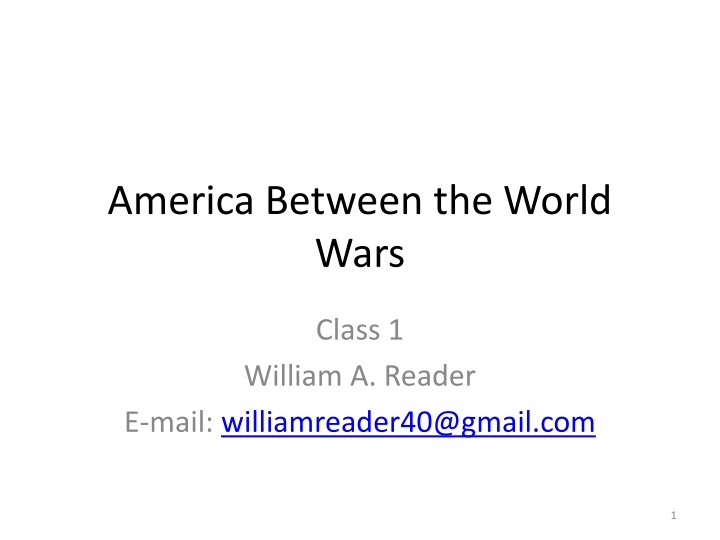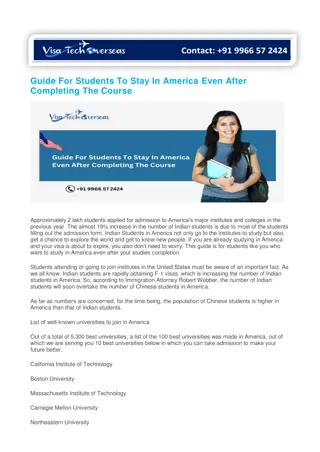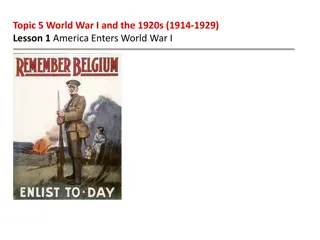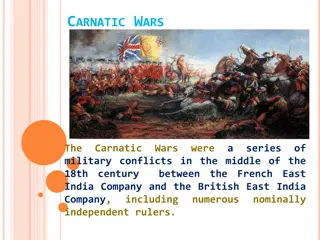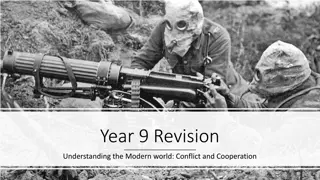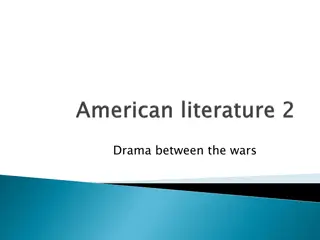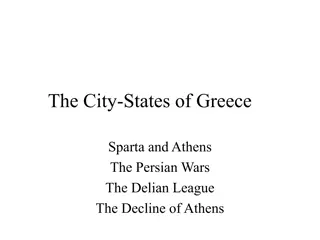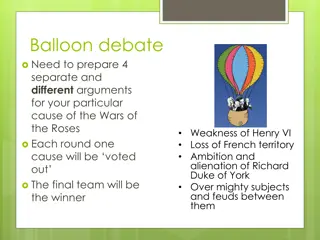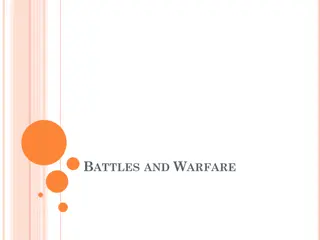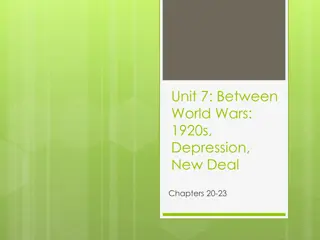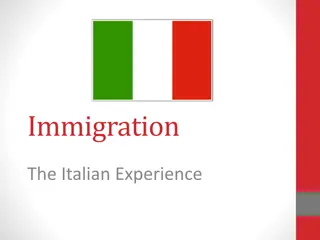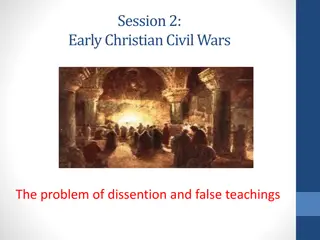America Between the World Wars: Innovations and Impacts
Explore the era between World War I and World War II, discovering the origins of various innovations like radar, nylon, Monopoly, and more. Delve into the economic, social, and political effects of World War I, the Russian Revolution, and the Influenza Pandemic, along with Woodrow Wilson's decisions. Uncover the significance of this transformative period in shaping modern America.
Download Presentation

Please find below an Image/Link to download the presentation.
The content on the website is provided AS IS for your information and personal use only. It may not be sold, licensed, or shared on other websites without obtaining consent from the author.If you encounter any issues during the download, it is possible that the publisher has removed the file from their server.
You are allowed to download the files provided on this website for personal or commercial use, subject to the condition that they are used lawfully. All files are the property of their respective owners.
The content on the website is provided AS IS for your information and personal use only. It may not be sold, licensed, or shared on other websites without obtaining consent from the author.
E N D
Presentation Transcript
America Between the World Wars Class 1 William A. Reader E-mail: williamreader40@gmail.com 1
Why Is This Important? The era between America s entry into World War I and America s entry into World War II is an important era much that defines our modern world and modern America had its roots in this era Many of you had parents and/or grandparents who came of age and lived through this era Understanding the world they lived in will help us understand them 2
Some Innovations that Originated Between WWI and WWII - 1 Hertz Rent-a-Car Aerosol cans Ballpoint pens Daylight Saving Time Academy Awards (Oscars) Electronic computer American Legion Radar Electron microscope United Parcel Service Scotch tape Superman Thompson sub-machine gun Macy s Thanksgiving Day Parade Birdseye Frozen foods National Football League Drive-in movies Bugs Bunny Radio Broadcasting Time & Newsweek Chanel #5 Color & Sound Motion Pictures Xerox copies Loudspeakers Band-Aids Gallop Poll Walt Disney cartoons Television Paperback books TheBig Bang Theory 35mm cameras Nylon Radio astronomy Monopoly Canned beer FM radio 3
Some Innovations that Originated Between WWI and WWII - 2 Good Humor Ice Cream Bar Alka Seltzer Sliced bread Chanel No. 5 Monopoly board game Chlorofluorocarbons Fast Food Chain Restaurants White Castle Colonial Williamsburg Fluorescent lamps Bureau of the Budget (predecessor of OMB) Tomb of the Unknown Soldier NBC & CBS Reader s Digest Electric guitar Waring blender 35mm Camera Teflon Instant coffee Book-of-the-Month Club LSD Helicopter Schick electric razor Freeze-drying Kleenex Blondie & Dagwood Batman Desk-model Stapler Jet engine Life magazine Pap Tests 4
What We Will Cover Today Impacts of World War I and the Treaty of Versailles Economic, Social & Political Effects Financial Agricultural Industrial Political Other Impacts of the Russian Revolution The Influenza Pandemic Immigration Restriction Woodrow Wilson s Four Great Mistakes Begin discussion of Prohibition 5
Effects of World War I You can t understand the 1920s and 1930s without understand the impact of WWI Most of what happened in the 20th century had its roots in WWI and the resulting peace treaties The Russian Revolution The Great Depression World War II The Cold War Vietnam The Arab-Israeli Wars The two U.S. wars with Iraq 6
The Russian Revolution -1 The war placed a major strain on the Russian economy Decline in civilian production Rampant inflation, especially in the cities Inadequate railroad infrastructure The Ottoman Empire cut Russia off from the Western Allies Prevented the Allies from shipping supplies to Russia Led to the ill-fated Dardanelles campaign Made Kamal Ataturk and unmade Winston Churchill Fostered a sense of Turkish, Australian, and New Zealand identity 7
The Russian Revolution - 2 Decline of the Russian economy led to the February Revolution The failures of the Provisional Government led to the October Bolshevik coup Intermediate result: Russian Civil War End Result: A Communist Russia 8
Effects of a Communist Russia Split the World Socialist movement into a Communist wing and a Democratic Socialist wing. Founding of the American Communist Party as a response to the events in Russia The Communist Revolution in Russia and the Founding of the American Communist Party Led to: The Red Scare in the U.S. & A fear of Communist revolution among both political elites and the political Right in Europe 9
Impact of the US Involvement in WWI US involvement in WWI had impacts in many different areas Financial Agricultural Industrial Political Other 10
Financial Impact of WWI - 1 Sizable increase in the national debt Led to postwar policies of cutting federal govt expenditures Income Tax becomes the dominant mode of taxation Mass marketing of war bonds as both an investment and as a means of showing one s patriotism Made a large proportion of the American public bondholders 11
Financial Impact of WWI - 2 Generated a high-degree of inflation CPI doubled between 1915 and 1920 Led the Federal Reserve to raise the discount rate from 4% to 7% The resulting recession was a major factor in the defeat of the Democrats in the 1920 Election Other factors were the abrupt cancellation of war contracts and the process of demobilization 12
Agricultural Impact of WWI - 1 European food production declined as agricultural manpower was drafted into military service Led U.S. farmers to vastly expand agricultural production Farmers took on mortgages to purchase land and to mechanize agricultural production Mechanization and chemical fertilizers led to a vast increase in productivity 13
Agricultural Impact of WWI - 2 A Depressed agricultural economy in the 1920s due to: Post-war return of European agriculture to normal levels of production The increased productivity and expanded output of American agriculture which led to: Crop surpluses, Low farm prices Farmer agitation for measures that would restore parity 14
Industrial Impact of WWI - 1 Created a big demand for munitions, steel, motor vehicles, communications equipment, and ships Turned DuPont into a chemical-industrial giant Created a planned economy run largely by big business interests via the Federal Government s War Industries Board (WIB) WIB had over 60 commodity divisions relating to specific industries that: Were largely staffed by people from the industry Were interwoven with the supply departments of the Army, Navy, other Federal agencies, and even the Allies 15
Industrial Impact of WWI - 2 WIB Conservation Division standardized a whole host of products in terms of size, color, versions, and variety E.g. Sizes, colors, & varieties of clothing; the shaping and sizes of drill bits & screw threads Prior to WWI, each company and industry had determined its own standards 250 types of plow models 755 types of drills 16
Industrial Impact of WWI 3 WIB Price-Fixing Committee was responsible for: Setting prices to control inflation Guaranteeing a fair profit to the producers in order to stabilize the market 17
Industrial Impact of WWI - 4 The Food Administration Headed by Herbert Hoover Persuaded Americans to eat fish and vegetables in place of wheat and meat Promoted wheatless and meatless days Popularized spaghetti (pasta with tomato sauce) as both a meat strecher and as a dish for meatless days Standardized food sizes & portions Standardized the size of bread loaves 18
Industrial Impact of WWI 5 Provided a model For big business, a model of what could be achieved by national coordination and cartelization For liberal intellectuals, a model that was An alternative to both laissez-faire capitalism and Soviet communism A way of transcending the weaknesses and social conflicts of both of the above For the FDR Administration, a model for many New Deal agencies and programs 21
Political Impact of WWI - 1 Wilson created the Committee on Public Information headed by George Creel (CPI) to create the war spirit necessary to fight the war Led to an upsurge of anti-German hysteria Based on propaganda demonizing everything German Pioneered in the use of media celebrities to propagandize and sell war bonds Erosion of civil liberties Suppression of anti-war groups Suppression of the American Socialist Party 22
Political Impact of WWI - 2 Made possible the enactment of Prohibition Supporters of Prohibition exploited the belief that drink impeded industrial productivity and soldierly fighting ability The Anti-Saloon League successfully linked liquor to disloyalty and beer-drinking with sympathy to the kaiser and his Huns Led to the Post-war Red scare The Russian Revolution and the founding of the American Communist Party led to a fear that revolution could happen here This fear was intensified by the 100% Americanism promoted by the war and the Creel Committee 26
Political Impact of WWI 3 Anti-German hysteria (and the Red Scare) in turn led to: A stress on 100% Americanism Immigration Restriction Immigration Act of 1917 Emergency Quota Act of 1921 Immigration Act of 1924 (National Origins Act) 27
Immigration Restriction Acts Immigration Act of 1917 Barred entry to immigrants from most of Asia Barred many categories of undesirables Barred immigrants age 16 and above who were illiterate Immigration Act of 1921 Limited the annual number of immigrants from each country to 3% of the number of persons from that country living in the U.S. in 1910 28
Immigration Restriction Acts -2 Asian Exclusion Act of 1924 Barred immigration from an Asia-Pacific triangle from Japan, China, Korea, India, and Southeast Asia Barred immigration of any persons ineligible for naturalization Non-whites were not deemed eligible for naturalization Provoked an official diplomatic protest from Japan 29
Immigration Restriction Acts -3 National Origins Act of 1924 Temporarily limited the annual number of immigrants After July 1, 1927 (later postponed to July 1, 1929) Imposed a total annual quota of 150,000 with the annual quota for any country or nationality being proportional to their proportion of the U.S. population in 1920 Gave non-quota status to wives and unmarried children of U.S. citizens and natives of Western Hemisphere countries 30
Other Impacts of WWI -1 Airplane Gave Hollywood dominance in the motion picture industry Consumer products Safety razors Wrist watches Kotex Cigarettes 31
Other Impacts of WWI 2 Spread Jazz from New Orleans to the cities of the North Created New Standards of What Was Considered to be Attractive From full-bodied to slim From Gibson Girl to Flapper Created the Conditions for the Great Influenza Pandemic of 1917-1919 32
The Influenza Pandemic - 1 Started on a pig farm in Haskell County Kansas Two events led to the virus becoming a pandemic: Annual Iowa Cedar Rapids Swine Show in September 1917, and Large-scale induction of Iowa & Kansas farm boys at Fort Funston First wave in the spring and summer of 1918 Unlike most flu, which have U-shaped death graphs, this flu had a W-shaped graph 33
The Influenza Pandemic 2 Flu spread from Camp Funston to other Army training camps and to Europe thanks to crowded barracks, sealed troop ships, and the fetid trenches of the Western Front Called Spanish Flu since neutral Spain did not censor news accounts of the flu Second (and most lethal) wave first appeared in September 1918 at Camp Devens MA 34
The Influenza Pandemic 3 Second wave virus singled out 20- and 30-year olds By the end of October 1918, 1 in 5 U.S. soldiers had been infected Virus provoked a hyper immune response which flooded the lungs with fluid This allowed secondary bacterial infections (most commonly pneumonia) to deliver the fatal blow 35
The Influenza Pandemic - 4 An estimated 50 million people died of the flu This included 550,000 Americans Roughly half who died were people in their 20s and 30s May have killed as many as 8%-10% of the people in the 20s-30s age group In many American cities, over half the population was infected 36
The Influenza Pandemic 5 WWI contributed to the Flu Pandemic in several ways: Providing an initial funnel of infection at Fort Funston Creating population movements of both refugees from areas of fighting and rural workers to areas of war-time employment in cities Creating a malnourished population in Europe By channeling more and more doctors and nurses into military-related medicine, it caused a deterioration of civilian medical care 37
Other Impacts of WWI 3 Created a potential market for ham and broadcast radio Large number of wartime radio operators American Legion and other veterans organizations Tomb of the unknown soldier Armistice Day (November 11th) as a national holiday Later renamed Veterans Day 39
Four Key Wilson Decisions - 1 1. The decision to turn the Paris peace negotiations into an extended summit Kept Wilson out of touch with what was going on in the U.S. Led Wilson to ignore the problems of war-related inflation and postwar demobilization This was to have deep implications for the Democrats in the 1920 election 40
Four Key Wilson Decisions 2 2. The decision to accept a flawed treaty in order to win foreign acceptance of the League of Nations Treaty contained provisions and omissions that Were politically unpalatable to the U.S. Senate Were to cause future trouble 3. The refusal to accept any changes or reservations in the Treaty to win Republican support 41
Four Key Wilson Decisions - 3 4. The Decision not to resign the Presidency after his stroke Led to the U.S. being governed by Wilson s wife This meant that the problems of postwar inflation, demobilization, and recession were totally ignored Let the Lodge Republicans dominate the debate over ratification of the Versailles Treaty This sapped support for the Treaty and led to its eventual defeat 42
Impact of the Treaty of Versailles Led to great resentment in Germany Signing the Versailles diktat weakened the Weimar Republic, giving the German Right (and the Nazis) a tool with which to attack the Republic Created instability in Eastern Europe Created weak and unstable states Strengthened Germany strategically Constituted a peace settlement that neither Germany nor Soviet Russia supported 43
Impact of Failed Ratification Greatly weakened the League of Nations Fostered a sense of disillusionment With World War I and its results With U.S. participation in the war With U.S. engagement with the world This in turn fostered a spirit of isolationism that was reflected in restrictive immigration laws, high tariffs, and the Neutrality Acts of the 1930s 44
The Impact of High Tariffs Harding and Coolidge Administrations followed a policy of: Mimimalist government Lowering taxes Paying down the National Debt Support of high tariffs High tariffs Reduced European access to the U.S. market Made Europe dependent on U.S. bank loans to pay war debts, reparations, and buy U.S. goods 45
